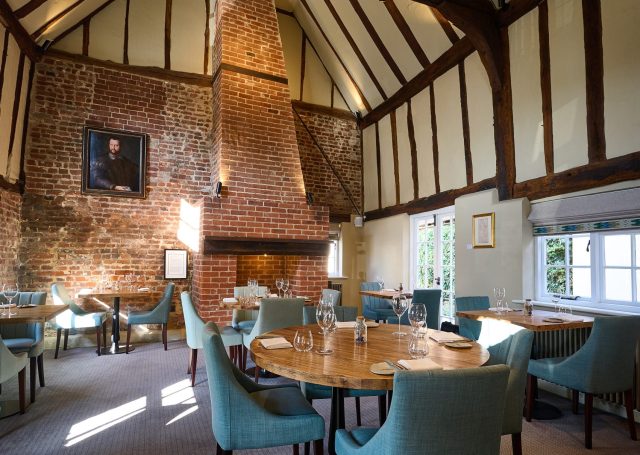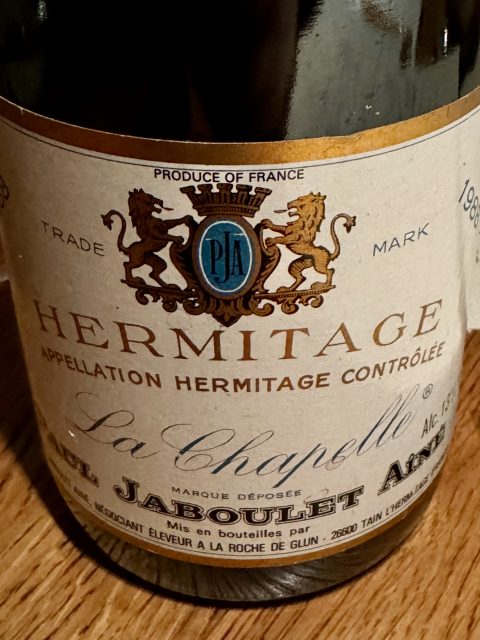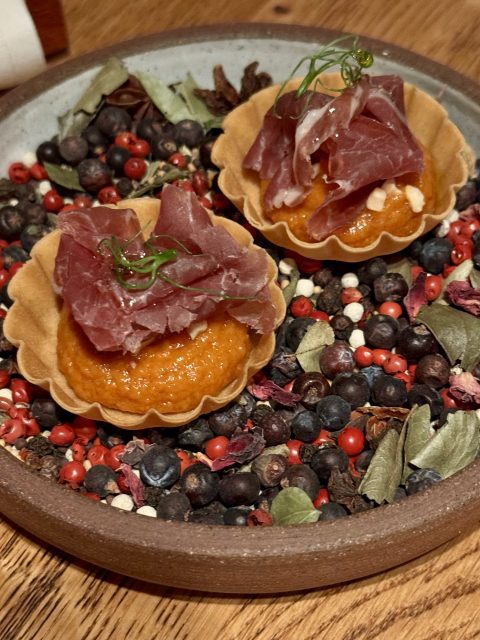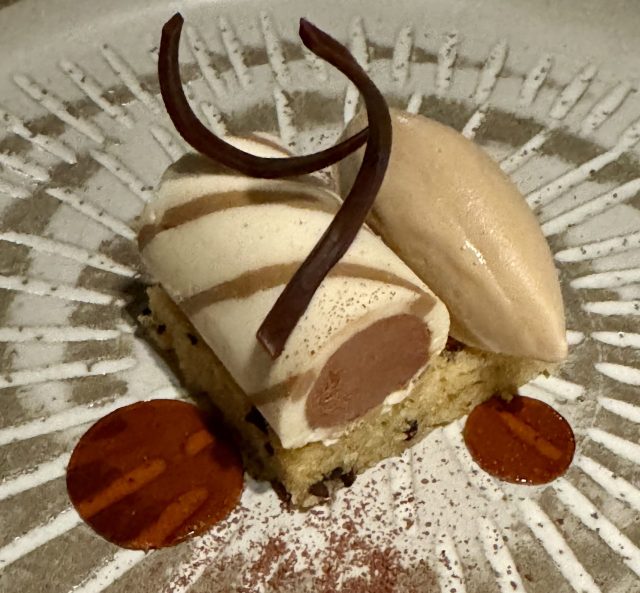Wine List Confidential: The Angel Inn, Stoke-by-Nayland
Douglas Blyde ambles over to East Anglia to see how siblings Richard and Elizabeth Clark have transformed The Angel Inn pub into a gastronomic hotspot with “carefully contemplated wine matches”.

“Pack loose clothing for a nine-course tasting menu at this refurbished pub with rooms in Constable country” advised Laura Jackson in The Times, while The Good Food Guide praised a larder including “wagyu beef, Herdwick lamb, fat scallops and wild salmon.” Michelin noted “the Spanish-born chef applies some subtle influences from his homeland” to such ingredients.
Design
Set in a village dating to 946, The Angel Inn was acquired “in a poor state” by Richard Clark and his sister, Elizabeth in 2011. The historic buildings were deeply restored, “while carefully incorporating twenty-first-century services and infrastructure,” says Clark. The results, envisioned by interior architect, Alex Cotton, subtly conceal air source heating and air conditioning, with windows being draught-free. Notable are the artworks on these historic walls given Clark formerly specialised in art law. Hence, pictures from the family collection range from Cosimo di Medici, Grand Duke of Tuscany, to post-war and modern British works by Peter Lanyon and Graham Sutherland.
The courtyard garden betwixt stable annexe and inn, are rich in purple hues, with a feature trough fountain. These were conceived by Thomas Hoblyn, whose Boodles Secret Garden was acclaimed at RHS Chelsea. In addition to The Angel Inn, Clark owns sister site, The Anchor Inn, two miles south in Nayland, known for its jazz-led Wednesdays. Called “Anchor Sessions”, recordings from these form the upbeat playlist at The Angel Inn. However, it is unclear why there is not a reciprocal exchange whereby the talented head chef of The Angel Inn could consult on the menu at The Anchor. Although character permeates the entire property, the grandest space, the Well Room, right beside the kitchen, is unfortunately designated as an overspill or private hire, rather than being rightfully celebrated on a daily basis.
Drinks
Taking in Armenia, Croatia, and Uruguay, the worldly list is overseen by Clark whose love for wine goes back over forty years when he undertook the management of his family’s wine cellar “and went on a number of courses including trips to several wine-growing districts and vineyards in Bordeaux, Burgundy, the Napa Valley, and various parts of Italy.”
Options by the glass range from the perky Macedonian Cuvée Cyril Tikveš 2021 (£7/125ml) to the millefeuille of nuances, Pichon Baron 2001 at £73.50 for a 175ml portion via Coravin.

With the exception of the organic Lelarge-Pugeot, Champagnes are drawn from easily recognised brands, including 1998 Dom Pérignon, either in standard release (£520) or as late release P-2 (£1,100), subject to mark-ups of £100 and £300 respectively. There is also one sparkling option from England, a territory Clark is expanding, being Goring Brut “Family Release” from Wiston (£88).
From the core list, some 30 wines are offered at less than £50 a bottle, starting from the optimistically titled Domaine de Joÿ 2021 L’Eclat 2021 from Côtes de Gascogne (£30). Above £50, things become more interesting, with “Sea of Love” Pinot Blanc from Battersea-based urban winery, Black Book at £59. Hover around the £100 mark, and you will reap the benefits of age, without high pressured mark-ups, as shown in Peter Sisseck’s 2013 Psi (£98) and the 2009 Ghemme by Torraccia del Piantavigna, which combines Nebbiolo with Vespolina, a variety so named because it is believed to attract wasps when ripe (£105).
Forming the second chapter of the list is the “Private Collection”, predominantly drawn from the family cellar. This stars big guns at close to retail price. Beating Bordeaux bins include 1982 Mouton (£1,900) and Petrus 1997 (£3,900). Other incursions from L’Hexagone include Paul Jaboulet Aîné’s 1988 Hermitage La Chapelle (£395), and 2010 Puligny-Montrachet Les Enseigneres from Coche-Dury (£2,250). Alongside Wine Spectator “Wine of The Year” 1997 Solaia (£590), is, given its grape, a bottle from Lazio born to challenge vinous know-it-alls, being Alberico Fattoria di Fiorano Sémillon 2015 (£115).
From outside Europe, is the hard-to-find 2012 Cuvée Elizabeth Occidental Station Vineyard Pinot Noir from Bodega Headlands (£305), and, also from the USA, 1994 Volcanic Hill Cabernet from Diamond Creek (£905). Meanwhile, 2009 Penfolds Grange may be yours for £565. The oldest bottle is from 1966 – Quinta do Noval (£305). In his forthcoming Unfiltered interview with the drinks business, Clark mentioned that “time travel would be handy” a superpower, though this last bottle could, albeit briefly, transport him into another epoch.
The glassware is mouth blown Elia Leila crystal.
Dishes
Rubén Aguilar Bel has steered the kitchen, which he redesigned, since the summer of 2021. The CV of the former “best young chef in Valencia” includes: El Racó de Can Fabes (RIP), Akelarre, and Mugaritz in Spain from where he originates, and Pétrus, and Canvas (RIP) in London where he took over from the unique Michael Riemenschneider. Bel’s Transylvania-born wife, Gabriella, is in control of pastry. Over a breakfast of unpasteurised, warmed Baron Bigod on toast, she mentioned how, in 1990, she “escaped” Romania for Hungary at the age of eight, which is where the couple ultimately began their story together in 2012.
They went on to work in Majorca and Verbier, as well as London; Bel also spent a year in major port city, Tianjin in northeastern China, delivering “700 paellas per month” having sifted through the bounteous rice market for the most apposite variety. The team also comprises sous chef, Mark Oakley, and the notably exuberant chef de partie, Jack Grestock. The Suffolk larder features prominently, notes Clark, given the county is “blessed with a wide range of wonderful local food suppliers [including] fish from the Suffolk coast, excellent farms and orchards.”
We dined on the invitation of the restaurant’s unofficial publicist, and devout epicurean, Linda Keenan, a formidable marketeer for the likes of Maxwell House USA turned expert in the equestrian. Her late husband, Jack, was a legendary figure in the drinks world. Having helped build Diageo, he and Linda became backers of restaurants including Noble Rot, while he was also a consultant to this publication.
Partner Content
Wines tonight were poured, and eloquently explained by, barman, and Ipswich Town fanatic, Tom Clowes-Whitby, who is part of a committed, homegrown team.

Dinner began with a notably light sourdough from flour from one of the country’s two operating tide mills, located in Woodbridge, with custard coloured Ampersand Dairy butter. A quartet of snacks, forming their own mini tasting menu, ensued. Encapsulated in strong but slender pastry pressed by Grestock, Catalan Romesco-Cecina tartalete bore a delicate heat; a tranche of ginger and lemon cured wild salmon with Bramley apple, celeriac, and sun blush tomato was of sashimi quality, though could have been cut into two parts for easier consumption; a garlic soup, supple, cosy, rich but not overpoweringly so, concealed a perfectly poached quail’s egg, and “Grandma’s” Iberian ham croqueta erupted with velvety bechamel dotted with jamón niblets once the particularly brittle outer shell was compromised. With these, Clowes-Whitby chose perennial favourite Crémant of the Wine Society, Cuvée Julien Dopff au Moulin NV from Alsace, “which we pour at the table to get conversation going,” he said. The oak-free Pinot Blanc and Auxerrois blend is produced, paradoxically, by a thirteen-generation family of former coopers. While pleasant, one wonders if the acidity of a more conspicuous in flavour homegrown sparkler might better cope with the array of flavours and textures.
The first course proper constituted, as The Times’ critic had hinted, a plus size Orkney scallop, magnificently raw beyond its seared summit, adorned with a near translucent potato “crystal” wafer evoking an executive salt and vinegar crisp – which ought to be available by the basket. There were incursions, too, of seasonal green asparagus, a pine nut and ventreche dressing, soy, and more jamón. Given a diver caught the scallop from the depths of the sea, Clowes-Whitby aptly fished an old vine Albariño from the cellar which spent six months under the waves. Chosen “to balance the fat of the ham”, Attis Bodegas y Viñedos “Mar” 2020 possessed a tangibly saline freshness and was the first of two wines playlisted in homage to Bel’s country of origin.
Bel’s next dish referenced one encountered during his first role in the UK at Pétrus. At the start of his four months at the Ramsay restaurant, Bel’s grasp of English was so minimal that the kitchen team could not understand what he was reading out from the kitchen printer, “though they did appreciate that I could cook,” he recalled. A wild mushroom raviolo closely filled with chestnut, hedgehog, black trompette and girolles sourced by “Paul the forager” was hidden beneath an initially blank looking Manchego foam, largely colourless other than for flecks of lime zest. Onto this, Grestock rained truffle sourced from the vicinity of Bel’s hometown Sarrión in the province of Teruel, Aragon, in such quantity that an unseen dog in a distant dining room barked in expectation. “I came out to do the truffle because Rueben sometimes doesn’t put enough,” Grestock half-joked.
With this, Clowes-Whitby poured another Galician from the two and a half decade old Attis Bodegas Y Viñedos: Sousón 2016. Displaying the other face of Janus compared to the eager, spring-like Albariño of before, the brooding, wintery Sousón, of which the producer made only 950 bottles, initially gave the impression of cork taint on the nose, while the taint-free palate, which evoked an indefatigable Portuguese Colares from hundreds of miles south, grudgingly developed alongside the dish’s fine fungus core. An intellectual rather than pleasurable match.
A surprise dish, entitled “Rice” followed. Encapsulating “Spain in a bite”, said Bel, this comprised aged Carnaroli rice, Lake District hare, and raw baby king oyster mushroom, all concealed beneath a negligee of lavishly flavoursome chicken stock jelly. With this moreish, textured dish, Clowes-Whitby was forced to ad lib, choosing adroitly, a fluted bottle of Feudi di San Gregorio’s Cutizzi Greco di Tufo 2021 which brought a complimentary clap of mint.
The first of two charcoal grilled dishes ensued, being Cornish red mullet with broad beans, chervil, confit squid, pools of lemon emulsion, and a noodle painstakingly formed of dashi. This was served with a bowl of satisfyingly textured ice crystal like fried fish scales. Staying in Italy, and with the generally favourable 2021 vintage, from a bottle bearing a Mars-like label, Clowes-Whitby poured a coastal, lip-stinger Falanghina from a 2.5-hectare vineyard further north in Molise, being Passo alle Tremiti 2021. “Being a bartender, I love citrus,” he noted of the citrus notes found in the glass, and frequently, Bel’s plates.

Clark had stipulated staunch Hermitage La Chapelle, Paul Jaboulet Aîné 1988 with the next dish, poured half an hour beforehand via Coravin. This conferred black olive notes, also favoured by chef, to Iberico pork secreto. Its tender, pink flesh was neatly arranged on a plate made in Amsterdam evoking the cross section of a tree trunk, with roasted salsify, and an intrinsic anchovy and, gently ascending in heat, guindilla garum crumble, as well as a trompette mushroom which dovetailed with the distant truffle notes of the wine. A first-class interaction.
The first of two desserts celebrated caramelised baked apple, with lemon parfait, a little ginger gel, and, handled with care, dill ice cream. Its citrus-ginger aspects were lushly mirrored in Saint Clair’s 2018 Noble Riesling, Geoffrey’s Creek, from New Zealand, which regularly appears on the wine matches at The Angel Inn. Fortunately, a hankering for a really rewarding dessert was subsequently satiated in “Coffee & Chocolate”, in which a 64% chocolate mousse peeped from within a tonka bean layer, beside a subtle coffee sorbet. These components rested on a cocoa nib speckled olive oil cake inspired by the chocolate in a baguette which the child Bel was often given by his mother “for energy”. Clowes-Whitby poured a 1997 unfiltered LBV Port from Quinta do Noval because “it is nice to finish with a fortified.” Indeed. It brought delightful cherry notes to both this, and petit fours including a black olive chocolate which we were invited to guess the flavour of.
Last word
Cared for by a team buoyed by their win of a third AA rosette in the same week of our visit, we found a confident, creative kitchen, and carefully contemplated wine matches drawn from a wine list with gravity. Here is a team, and a venue, deserving commendation.
Best for
- “Private Collection” wines
- Well Room private room
- Honeysuckle-scented courtyard garden
Value: 94, Size: 93, Range: 93, Originality: 94, Experience: 96; Total: 94
The Angel Inn, Stoke-by-Nayland – Polstead St, Stoke-by-Nayland, Colchester CO6 4SA; 01206 263245; angelinnsuffolk.co.uk; info@angelinnsuffolk.co.uk
Related news




